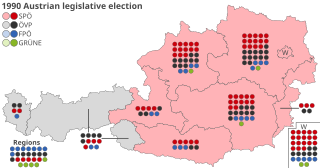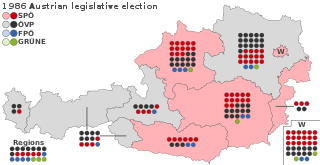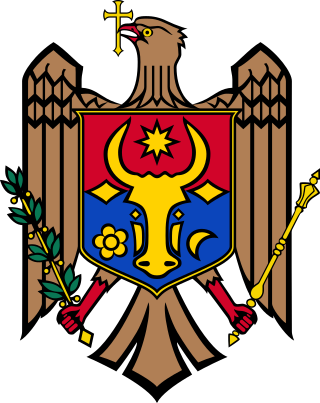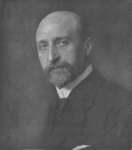
Early parliamentary elections were held in Austria on 24 November 2002, after internal divisions in the Freedom Party of Austria (FPÖ) culminating in the Knittelfeld Putsch led to the resignation of several leading FPÖ members. The result was a victory for the ÖVP, which won 79 of the 183 seats, the first time it had been the largest party in the National Council since 1966. It continued its coalition government with the FPÖ, which had lost almost two-thirds of its seats. Voter turnout was 84.3%.

The Landbund was an Austrian political party during the period of the First Republic (1918–1934).

Parliamentary elections were held in Austria on 9 October 1994. The Social Democratic Party of Austria (SPÖ) and Austrian People's Party (ÖVP) remained the largest parties, but both suffered losses to minor parties. The Freedom Party of Austria (FPÖ) improved to 22.5% and The Greens won 7.3%. The Liberal Forum, a liberal splinter from the FPÖ, won 6.0% and entered the National Council on its first attempt. The incumbent grand coalition of the SPÖ and ÖVP was renewed.

Parliamentary elections were held in Austria on 7 October 1990. The Social Democratic Party won the most seats, and retained the grand coalition with the Austrian People's Party. Voter turnout was 86%.

Early parliamentary elections were held in Austria on 23 November 1986. They were called by Chancellor Franz Vranitzky of the Socialist Party (SPÖ), as he was not prepared to continue the coalition government with new Freedom Party (FPÖ) leader Jörg Haider, who had ousted Norbert Steger at the party convention.

Parliamentary elections were held in Austria on 6 May 1979. The Socialist Party won a fourth term in government, taking 95 of the 183 seats. Voter turnout was 92.2%. As of the 2017 elections, this is the most seats that an Austrian party has won in a free election, as well as the last time that an Austrian party has won an outright majority.

Early parliamentary elections were held in Austria on 10 October 1971, following electoral reforms intended to benefit smaller parties. The number of seats in the National Council was increased from 165 to 183, and the proportionality of the seat distribution was increased as well.

Parliamentary elections were held in Austria on 1 March 1970. The result was a victory for the Socialist Party, which won 81 of the 165 seats to become the largest party for the first time in the Second Republic. With the SPÖ two seats short of a majority, SPÖ leader Bruno Kreisky became Chancellor at the head of a minority government that was tolerated by the Freedom Party of Austria in return for electoral reforms that benefitted smaller parties by increasing the proportionality of votes and seats. Voter turnout was 91.8%. It was the first Socialist-led government since 1920, and the first purely left-wing government in Austrian history. The SPÖ would lead the government for the next 29 years.

Parliamentary elections were held in Austria on 18 November 1962. The result was a victory for the Austrian People's Party, which won 81 of the 165 seats. Voter turnout was 94%. Although the People's Party had come up only two seats short of an outright majority, Chancellor Alfons Gorbach retained the grand coalition with the Socialists under Vice-Chancellor Bruno Pittermann.

Federal elections were held in Germany on 14 September 1930. Despite losing ten seats, the Social Democratic Party of Germany (SPD) remained the largest party in the Reichstag, winning 143 of the 577 seats, while the Nazi Party (NSDAP) dramatically increased its number of seats from 12 to 107. The Communists also increased their parliamentary representation, gaining 23 seats and becoming the third-largest party in the Reichstag.
The Democratic Party is a centre-right political party in Bulgaria led by Alexander Pramatarski. The party was a member of the European People's Party (EPP).
Parliamentary elections were held in Finland on 1 and 2 October 1930. The Social Democratic Party emerged as the largest in Parliament with 66 of the 200 seats. Voter turnout was 65.9%.

Parliamentary elections were held in Norway on 20 October 1930. The Labour Party won the most seats in the Storting.
The Russian Party in Estonia was a minor political party in Estonia.

Parliamentary elections were held in Austria on 17 October 1920, although they were not held in Carinthia until 19 June 1921 and in Burgenland until 18 June 1922. They were the first regular elections held after a permanent constitution was promulgated two weeks earlier.

Constituent Assembly elections were held in Austria on 16 February 1919.

Parliamentary elections were held in Austria on 21 October 1923. The result was a victory for the Christian Social Party, which won 82 of the 165 seats. Voter turnout was 87.0%.

Parliamentary elections were held in Austria on 24 April 1927. The result was a victory for the Unity List (Einheitsliste), an alliance of the Christian Social Party and the Greater German People's Party, which won 85 of the 165 seats. However this brief coalition failed to result in any larger proportion of the votes than when the CSP ran alone, losing votes to the Landbund. Voter turnout was 89.3%.
Parliamentary elections were held in Bosnia and Herzegovina on 11 November 2000. Voter turnout was 64%.

The Labour Party is a minor political party in Moldova led by Gheorghe Sima.




















